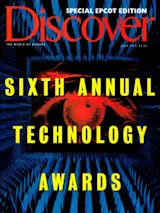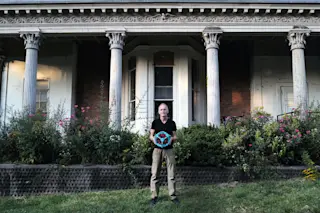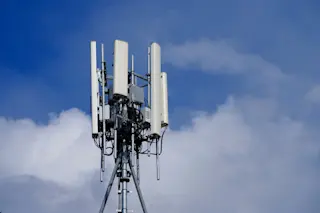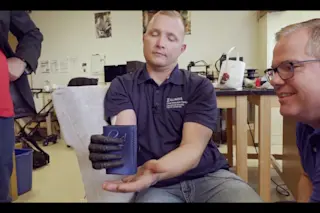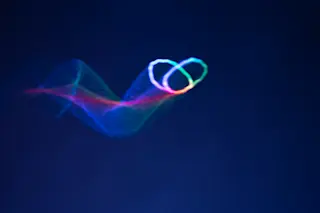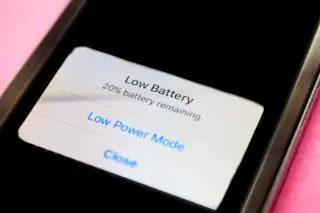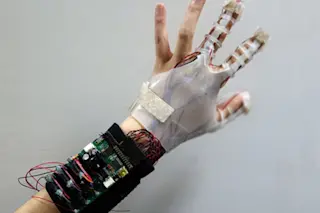Visitors to the Smithsonian’s National Air and Space Museum in Washington, D.C., are seeing the space suits once worn by the men who walked the moon in literally a whole new light. The Smithsonian is the first customer to use a new kind of lightbulb that is brighter and more energy efficient and emits less ultraviolet radiation than conventional lighting.
This is the proverbial perfect lightbulb, says Michael Ury, vice president of engineering and cofounder of Fusion Lighting in Rockville, Maryland. In 1990 he put a pinch of sulfur in a quartz bulb filled with the inert gas argon and bombarded it with the kind of microwaves found in an ordinary microwave oven. The microwaves kicked the sulfur atoms into a higher energy state, and when their electrons settled back into their original orbits, they released photons--lots of them, spanning the visible spectrum.
Ury, who received funding from the Department of Energy, developed a bulb with its own tiny microwave generator--the same as the one in your microwave oven, except a bit more ruggedly built. The light is so bright that 94 mercury and incandescent lamps in the Smithsonian’s Space Hall were replaced this past October with just three of Ury’s sulfur bulbs. The new bulbs provide three times the light and use 25 percent less energy, and their low level of ultraviolet light doesn’t harm the moon suits or other items on display. Since the sulfur bulbs have no filament or electrodes, they should last a long time without wearing out. We’ve run these bulbs almost 10,000 hours in test cases, and there’s no wear and tear, says Ury.
Fusion Lighting expects the bulb to catch on in sports arenas, malls, factories, and warehouses within the next five years. It may take longer, however, to reach the home. The lightbulbs in these demonstrations produce approximately 450,000 lumens, says Ury. Your average incandescent bulb produces 1,700. So we’d have to make them much smaller. And much cheaper. But it’s possible.
Boiling Bugs
Aqua Heat Technology’s Soil-Sterilizing System
Innovator: Harry Rajamannan
Purely by accident, in 1989 Harry Rajamannan came up with a system for killing weeds: he sprayed them with hot water. Hot water, it seems, dissolves the leaves’ waxy coating, allowing the moisture inside to escape. Although the method worked well enough, Rajamannan admits it was not a major discovery. The entrepreneur was looking for a green method of killing bugs, not weeds.
In 1992, however, the Environmental Protection Agency decided to ban methyl bromide, a cheap, widely used pesticide, as of the year 2000. As it turns out, the substance is one of the most potent ozone depleters known to science, and each year American farmers use 64 million pounds of the gas to sterilize soil and kill the nematodes and fungi that attack strawberries, tomatoes, and other fruits and vegetables. Without a clean alternative, billions of dollars in crops could be threatened.
Nothing could be cleaner, of course, than hot water. So Rajamannan, president and founder of Aqua Heat Technology of Minneapolis, took his weed-killing machine, equipped with a diesel-powered heater that can boil 250 gallons of water per minute, and added a rototiller that breaks up clumps of soil and injects hot water 14 inches into the ground, where most of the bugs that kill crops dwell. A covering of plastic is all that’s needed to keep the heat in. We only need to raise the temperature to 115 degrees Fahrenheit for 40 minutes and we kill everything, all the nematodes and fungi, says Rajamannan.
In April, Rajamannan began the first full-scale tests of the machine: he’s using it to take a variety of vegetables and fruits all the way to harvest. And he’s already planning for the future. We’re not selling the machines--they’re too expensive, he says. We’re going to go out and service the farms. And we absolutely guarantee a kill.
Gassy Plastics
University of North Carolina at Chapel Hill’s Supercritical CO2
Innovator: Joseph DeSimone
To make plastics, chemists link monomers to form polymers, plastic’s basic molecules, which are then shaped into products too diverse to name. Since this linking reaction has to take place in a solution (water, for instance) and requires some sort of chemical catalyst, it produces a great deal of hazardous waste--567 million pounds of toxic chemicals and liquid runoff in 1992 alone.
Joseph DeSimone, professor of chemistry at the University of North Carolina at Chapel Hill, came up with a way to eliminate the liquid runoff. Instead of using water or some other liquid to support the linking reaction, he found a way of using carbon dioxide, which vaporizes at the end of its usefulness, or else can easily be recycled. The trick lies in making the carbon dioxide supercritical--that is, putting it under high pressure so that it takes on the density and other properties of a liquid, including the ability to act as a solvent in chemical reactions.
Indeed, the plastics industry would have pounced sooner on supercritical CO2 were it not for one catch: it mixes with monomers and polymers no better than oil mixes with water. To fix this problem, DeSimone designed a substance that acts like soap. Soap is a molecule that on one end likes water and on the other end likes oil, explains DeSimone. It has this dual nature to it. So what we did was design surfactants--soaplike molecules--that have a segment that likes CO2 and a segment that doesn’t like CO2. The surfactants’ CO2-hating end grabs on to the monomers, while their CO2-loving end keeps the monomers immersed in the supercritical CO2.
When DeSimone used the new surfactants to string together monomers of Plexiglas into balls of plastic, chemical giants DuPont, Eastman Chemical, and Hoechst-Celanese took notice and agreed to fund his research into other CO2 reactions.
Strip Ease
U.S. Air Force’s Bicarbonate of Soda Stripping System
Innovator: Richard Slife
Baking soda is great for making cakes and cookies. But who would think of using it as an airplane paint stripper?
The Air Force would. After all, the Air Force’s old paint- stripping chemical--methylene chloride--is one of 17 hazardous pollutants whose use the EPA has required to be cut drastically by 1998. For help, the Air Force turned to the Carolina Equipment Company of Charleston, South Carolina, which had devised a baking soda stripper for use in industrial cleaning. Unlike methylene chloride, which is applied as a spray and left to sit until the paint loosens and can be scrubbed off, baking soda works more like a sandblaster. Shot at the surface under high water pressure, the abrasive powder literally strips the paint then and there.
At first, however, it seemed as if the baking soda idea would never get off the ground. The industrial stripper uses air sucked in from its surroundings to propel the baking soda from the hopper, where it’s stored, to a hose nozzle, where it’s mixed with water. Problems arose when the air pressure in the aircraft hangars was found to fluctuate, throwing the system out of whack. We would get a quarter of an ounce of baking soda per minute, and then it would jump up to a pound and a half, says USAF materials engineer Richard Slife. If you have over a half-pound of baking soda per minute, you’re causing structural damage to the aircraft materials. And that’s a no-no.
Carolina Equipment and the Air Force teamed up to design a mechanical shaft--called an auger feed system--to deliver the baking soda more consistently. The auger’s rate of revolution is fixed so that no more than a half-pound of baking soda per minute gets into the air line.
The Air Force is now using the system to peel paint from cargo jets; the program may eventually halve what the Air Force spends on stripping paint.
Something in the Air
University of North Carolina at Chapel Hill’s Pollutant CT Scanner
Innovator: Lori Todd
Tracking pollutants in the workplace or emissions from industrial plants is a scattershot operation. Currently scientists take a few measurements in one particular spot, which gives them a good snapshot of emissions but tells them nothing about how emissions disperse into the atmosphere. People just take very quick measurements over a short period of time and use them to make guesses or judgments about what’s going on over the long term, says Lori Todd, assistant professor of environmental sciences and engineering at the University of North Carolina at Chapel Hill.
To better track pollutants, Todd invented what might be called a chemical CT scanner. Whereas medical CT scanners shoot X-rays through the body from different angles to obtain an image of an organ, Todd’s device shoots infrared rays through the air. Since each pollutant tends to absorb a unique spectrum of infrared light, Todd is able to use an infrared spectrometer to take a sort of chemical fingerprint that tells her which chemicals are in the air. The device allows her to take many simultaneous measurements over a wide area and put together a moving picture of how chemical emissions drift through the air. Todd’s goal now is to figure out the least number of beams needed to get reliable data.


